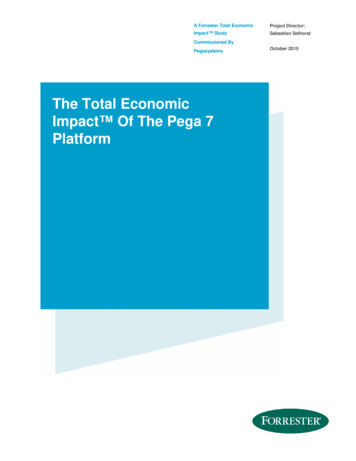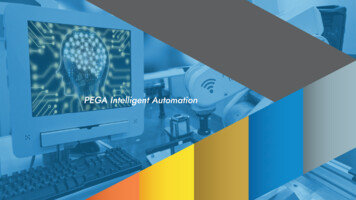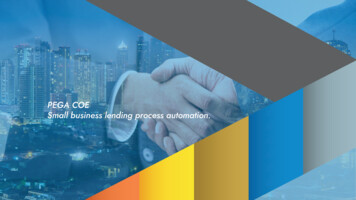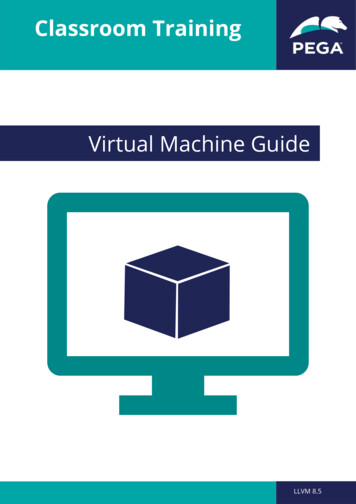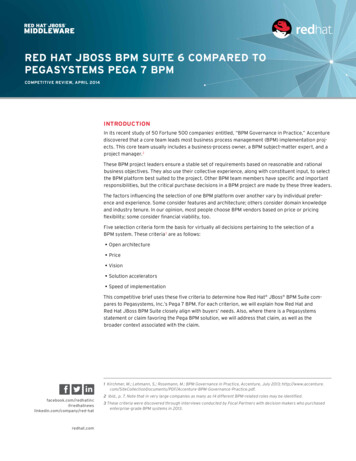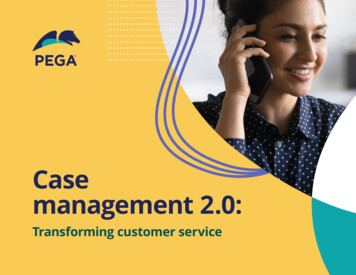
Transcription
Casemanagement 2.0:Transforming customer service
Contents3Stop repetition in the contact center4Improve process workflows with case management6The challenges of a channel-led customer service architecture7Welcome to customer service case management 2.010 Simplify service with multidimensional case management – in every case11 It’s time to upgrade your customer service
3 Case management 2.0: Transforming customer serviceStop repetition inthe contact centerChances are you and your customer service agents have heard this phrase before: “But I alreadygave you my account number.” And as a customer yourself, you’ve probably uttered it onceor twice. Repetition is a major friction point in the contact center. In fact, it’s the number onefrustration point for both customers and employees.1When asked what frustrates them during typical customer service experiences, customersranked “having to repeat information” as their number one answer. Likewise, when asked whatwas the main challenge their customer service departments face, business leaders and agentscited, “having to ask customers to repeat themselves.”But repetition is just a symptom of a much larger service problem.Resolution Revolution, Pega, 2021, pages 6 and 81What is the largerservice problem?Disconnectedsystems, channels,and work createinefficient serviceprocesses – breakingdown customer andemployee journeys.
4 Case management 2.0: Transforming customer serviceImprove process workflowswith case managementCustomer service is driven by a moment of need. Whether that’s because customers have encountered an issue with aproduct or service, have a complaint, or need to update their information, they are always looking for the same thing: quick,convenient ways to resolve their problems. And ideally in the service channel they prefer, such as phone, email, or SMS.Sometimes customer inquiries are simple and can be resolved on the spot, such as providing the balance on a bill. Othertimes, inquiries are complex and require multiple steps and activities to resolve. To manage these more complex inquiries,businesses have specific processes that help resolve customer issues. The sum of multiple tasks and activities required todeliver a service resolution is called case management.Common forms of software-based case management automate assigning work – that is the flow of work from one personto the next. They don’t necessarily automate the work itself. While these solutions are good for assigning and routing work,they are essentially just ticketing. They still require agents to know what to do next and to perform repetitive, manual tasksoften involving multiple systems and departments – leading to longer handle times and frustrating experiences for all.?
5 Case management 2.0: Transforming customer serviceCase management 1.0 is one-dimensional and has several shortcomings:1. It doesn’t orchestrate work across systems and channels.2. It lacks automation and execution, leading to manual work and longer resolutions.3. It doesn’t intelligently guide agents or bots to make decisions or get work done more efficiently.4. It leads to lengthy development backlogs of change requests that require extensive ITresources and increased costs.Unfortunately, this form of case management is still the norm in manycontact centers today.In fact, contact centers using basic case management are feelingincreased strain with higher inquiry volumes, disconnected channels,and increased customer expectations. They’re looking for waysto provide faster resolutions and contain call volume by offeringalternative digital routes and self-service options.
6 Case management 2.0: Transforming customer serviceThe challenges of achannel-led customerservice architectureBasic case management doesn’t solve the number one problemthat’s holding contact centers back – the disconnected channels,systems, and processes they rely on to resolve issues. Tocompound matters, customers want quick and easy resolutionson the channel of their choice, leaving businesses compelled tooffer service on a greater number of channels – even when itmeans having to create disconnected processes.68% of organizations now claim to provide omni-channel service.And for 70% of businesses, that means providing service on four ormore channels.2 With the addition of each channel, organizationsimplement new processes and risk creating process silos thatcompromise the seamlessness of the customer service journey.These silos lead to common agent frustrations such as havinglimited historical context of a customer or having to ask thecustomer to repeat themselves – frustrating everyone involved.In short, disconnected processes lead to dissatisfied customers andfrustrated employees. Customers will walk away after a poor serviceexperience, agents will eventually quit due to their increasingfrustrations, and IT teams will struggle to keep up with lists ofdevelopment change requests across siloed systems and channels.Resolution Revolution, Pega, 2021, page 3277% of customerswill walk away from abusiness after a badservice experience
7 Case management 2.0: Transforming customer serviceWelcome to customer servicecase management 2.0Luckily, the future of seamless, effective, and faster customer service ishere. Leading organizations have already realized the power of buildingtheir customer service strategy around the customer journey, rather thanfocusing on channels. Welcome to the next stage of customer serviceevolution – offering visibility of the entire case across all channels, as wellas the ability to seamlessly automate and execute the actual work (bothhuman- and machine-based). Welcome to case management 2.0.This outcome-driven, customer-centric, and channel-less approach drivesfaster resolution, cuts across silos, and serves as the multidimensionalfoundation for simplifying customer and employee journeys. Additionally,customer service case management 2.0 is infused with best practicesand is quick to deploy thanks to prebuilt, industry-specific case typesand data models.
8 Case management 2.0: Transforming customer serviceFrom channel-led to channel-less service architectureUnlike channel-led case management, a channel-less approach allows businesses to build from the center out – focusing on the customerjourney centrally, rather than building processes for each individual channel. By centralizing around customer outcomes, businesses canbuild case rules and logic in one central hub and then activate it in each channel they support to create a consistent experience across everyinteraction. This means that regardless of the channel a customer uses, they receive the same quality service.?CUSCATypical CS desktopFocus: Ticketing(Assigning the work)SE MTO MERA NAGEMENTPega Case ManagementFocus: Outcomes(The work itself)
9 Case management 2.0: Transforming customer serviceThe multidimensional approachto case managementEnsuring consistency across channels is just part of thepuzzle. Geographies, business units, departments, orteams can operate differently for certain channels orsegments. Despite all these variations, there are oftencommon elements across the business. By factoring inthe many dimensions of an organization, businessescan reuse common service process and logic, leavingconfiguration for variations and unique scenarios.Case management 2.0, or multidimensional caseWhy is multidimensional casemanagement, is an approach to orchestratingmanagement more effective?end-to-end service processes in one central hub. Itenables businesses to achieve faster outcomes acrossall channels, including self-service and assisted service,as well as proactive and preemptive service.1By automating the work itself,multidimensional case management cutsMultidimensional customer service case managementout mundane tasks and allows staff to focusblends artificial intelligence and process automation toon higher value activities.empower contact centers to make decisions and getwork done efficiently. It manages the work from themoment an inquiry is initiated through to resolution –guiding each step and stage of the relevant customerjourney as well as carrying the full context of thecustomer’s need along the way.2In addition to saving time, removing thesemanual tasks helps reduce costs and risk,and improves accuracy across the business.3With multidimensional case management,businesses can optimize across all channelsin a timely, scalable fashion.
10 Case management 2.0: Transforming customer serviceSimplify service with multidimensionalcase management – in every caseMultidimensional case management helps to: Clear the way: Multidimensional case management doesn’t just assign work – it gets work done withintelligent automation. It clears the way for agents by eliminating repetitive, manual processes, whilealso removing obstacles from a customer’s path – allowing for more autonomy and self-service. Improve visibility: With its ability to focus on individual customer journeys, this redefined casemanagement enables businesses to activate, track, and audit service cases across any and everytouchpoint – be it an agent desktop, mobile application, self-service, or interactive voice response. Reduce costs: Multidimensional case management pulls relevant customer background informationfrom across all service systems, including historical background, product, or service information,making it easier for agents to understand the full picture without toggling back and forth. This boostsefficiency and reduces the cost to serve. Contain more inquiries: Rather than simply automating the flow of work, multidimensional casemanagement makes every channel your best channel and every agent your best agent – just byautomating the work itself. This helps contain more inquiries and increase first contact resolution.Customers get the same quality resolution across digital channels and through self-service, leavingfewer inquiries that require an agent’s touch – once again reducing cost and letting agents focus ondelivering an excellent customer experience. Increase system value: One of the greatest benefits of multidimensional case management isthat it helps drive value to existing systems. All the benefits above are possible without ripping andreplacing your legacy desktop tools.
11 Case management 2.0: Transforming customer serviceIt’s time to upgradeyour customer serviceCustomer and employee demands of service will continue to evolve. Butthe future of service is all about simplicity. Faster resolutions, personalizedexperiences, and minimal effort from customers and employees are drivingthe future of the contact center. Businesses need more from their customerservice ecosystems – they need the ability to design once and deployacross all service channels. They need a way to account for all dimensionsof their business and the unique scenarios within each service process.This requires rethinking how they deploy and use case management.Multidimensional case management starts with the customer journey,allowing businesses to optimize their workflows, automate responses andPower your multidimensionalcase management with PegaTo enable the kind of customer journeys thatlead to better business outcomes, Pega’smultidimensional customer service casemanagement blends centralized artificialintelligence, robotic process automation,and low-code software development – all toempower contact centers to make servicingdecisions and get the work done quickly andeffectively. Pega’s customer service casemanagement is built on our Center-out business architecture that puts the customerjourney at the heart of all service processes.resolutions, and drive down costs. Multidimensional case managementPega Microjourneys – the lifecycle of workblends artificial intelligence and process automation to empower contactnecessary to deliver a specific, meaningfulcenters to make decisions and get work done efficiently, simplifying serviceoutcome – allow your organization to build afor agents and customers.single journey at a time, quickly automating themost frequent journeys for your agents. Betteryet, Pega Customer Service contains dozensof predefined Microjourneys out of the box.From address changes to transaction disputesto scheduling activities, these microjourneycase types drive the workflows that powermultidimensional case management. And thatmeans better outcomes, fast.
About PegasystemsPega delivers innovative software that crushes business complexity. From maximizing customerlifetime value to streamlining service to boosting efficiency, we help the world’s leading brandssolve problems fast and transform for tomorrow. Pega clients make better decisions and getwork done with real-time AI and intelligent automation. And, since 1983, we’ve built our scalablearchitecture and low-code platform to stay ahead of rapid change. Our solutions save peopletime, so our clients’ employees and customers can get back to what matters most.For more information, please visit us at pega.com 2021 Pegasystems, Inc. All rights reserved. All trademarks are the property of their respective owners.
case management with Pega To enable the kind of customer journeys that lead to better business outcomes, Pega's multidimensional customer service case management blends centralized artificial intelligence, robotic process automation, and low-code software development - all to empower contact centers to make servicing


